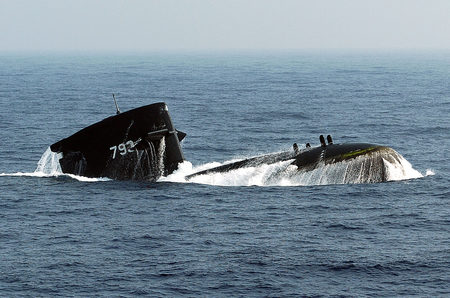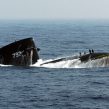
Taiwan Navy Sailing Ahead with Indigenous Submarine Program
Publication: China Brief Volume: 12 Issue: 7
By:

The Republic of China (ROC) Navy appears to be moving forward with a long awaited program to build diesel submarines in Taiwan. A domestic submarine program—which was aborted under former President Chen Shui-bian’s administration—reportedly has been resuscitated in President Ma Ying-jeou’s second term. While talk of an indigenous submarine program is nothing new, interest in the program resurfaced after local reports revealed that officials from Taiwan’s Navy had briefed a group of legislators in the Legislative Yuan’s (LY) Foreign Affairs and Defense Committee about the program during a classified meeting in late January (Taipei Times, February 21). Legislators from both the ruling-Kuomintang (KMT) and opposition-Democratic Progressive Party (DPP) reportedly attended the meeting. Moreover, unconfirmed reports suggest the program may be farther along than Western observers expect and presumably has the support of Taiwan’s political leadership. The latest move by the Ma administration to move forward with the indigenous submarine development program after his re-election may represent a realignment in the domestic political environment and growing concerns about China’s military deployments.
In the past decade, the fate of Taiwan’s elusive quest for submarines had been the subject of many conspiracy theories. Indeed, the program had been in a state of paralysis practically from the moment former President George W. Bush announced in 2001 that the United States would provide eight diesel-electric submarines to Taiwan. There were many reasons for the delay in the agreement’s implementation. In part, the program fell victim to partisan political gridlock and prevailing bureaucratic interests in Taiwan and the United States, and miscommunication about whether the platform should be acquired via the Foreign Military Sale (FMS) or the Direct Commercial Sales (DCS) channel (Taiwan Link, October 30, 2008). The 2001 submarine purchase plan—presumably the most important of the three major arms procurement targets—was dead in the political water ever since the U.S. Navy’s “independent cost estimate” of $9.8 billion sparked a boycott by the then opposition-KMT and People First Party (PFP) (Taipei Times, February 26). The combination of these factors, in no sequential order, contributed to why there has been little progress on Taiwan’s quest for submarines over the past ten years…perhaps until now.
During the classified briefing at the Foreign Affairs and Defense Committee, a senior official from the ROC Navy apparently asked for the major political parties’ support for the Fiscal Year 2013 budget, which included the indigenous submarine program (Straits Times, February 20). Ostensibly, the plan is to initially develop a 1,000 or 1,500 ton series with a deliverable prototype within three to four years (Taipei Times, February 21). Ever since the submarine program, codenamed the “Sea Star Project,” reportedly was aborted under the former DPP administration, there have been constant rumors about high-level meetings in Taipei concerning the program’s resurrection and of foreign participation in a feasibility study (“Is Russia Helping Taiwan Build Submarines?” China Brief, March 10, 2011; “Taiwan’s Submarine Program: Pipe-Dream or Next Big Thing?” China Brief, April 16, 2009). So the latest move could be interpreted as a signal that the program has finally reached an important milestone in terms of attaining a consensus among Taiwan’s political leaders. On February 21, when asked about the leak regarding the Ma administration’s policy on the indigenous submarine program, Ministry of National Defense (MND) Spokesperson Luo Shao-he stated the MND supports an indigenous submarine program. Luo added the MND would welcome such a decision if the relevant technological limitations are resolved (Central News Agency [Taiwan], February 21). The stars finally may be aligning for Taiwan’s domestic submarine program.
The Ma administration’s apparent decision to pursue the indigenous submarine program, however, did not occur over night. In 2009, several reports citing sources close to the National Security Council (NSC) claimed a study had been commissioned under the directive of the President. According to the Taiwan-based Liberty Times, the NSC reportedly issued an order to the Navy to undertake a feasibility study on Taiwan’s capability to indigenously build submarines (“Taiwan’s Submarine Program: Pipe-Dream or Next Big Thing?” China Brief, April 16, 2009). It also was reported “[a]t least five top-level defense meetings have been held to evaluate the possibility that the eight underwater warships can be locally assembled.” The meetings apparently recommended local construction of the submarines and a final report had been prepared for President Ma’s approval. Experts at the time believed “Ma is likely to give the green light for the local construction to stimulate the economy and help reduce unemployment” (China Post, April 7, 2009).
At around the same time, China Shipbuilding Corporation (CSBC), which is based in the southern-port city of Kaohsiung, revealed “[a] research plan is under way to build submarine hulls up to international standard” (China Post, April 7, 2009). In January 2011, the popular Taiwanese weekly Next Magazine reported there were plans to introduce Russian Kilo-class technology into its submarine design. According to the report, a task force was organized by the NSC and the Navy, which contacted Russian government authorities back in October 2010 and reached an agreement on technical cooperation to construct pressure hulls for the submarines (Next Magazine [Taiwan], January 27).
The CSBC Corporation also had established a “Preparatory Working Group for the Submarine Project,” the working group was later codenamed “Project Diving Dragon.” The plan involved the collection of information on submarine construction imitating the German 209 model submarines’ ship structure, conceptual designs, experimental computer modeling, and established a 46-member research team that invested 20,000,000 NTD (roughly $678,000) (Jianchuan zhishi [Ship Knowledge], August 2003). The aforementioned CSBC working group was also reportedly sent to France, Spain and Italy to different shipbuilding companies to acquire expertise and seek assistance. These shipbuilding companies were said to have sent specialists to assess Taiwan’s defense industries capacity to undertake domestic construction of the submarine. An assessment report is due for official release sometime in 2012 [1].
The change in attitude by the President’s closest advisors (NSC, MND and Taiwan Navy) also provides hints of this apparent shift in policy. For instance, when President Ma was elected to his first term in office back in May 2008, the NSC reportedly began holding meetings starting that July to address the submarine issue. Yet, because of the price tag shock of the submarine purchase through the FMS channel, moving forward on the program would have come at a heavy political cost. The government’s approach was to collect as many different inputs from defense experts, planners and industrial specialists. In spite of having more than 10 meetings, the experts, scholars, military leaders and shipbuilding representatives reportedly could not arrive at a consensus (United Daily [Taiwan], July 28, 2008). The push toward indigenous development of submarines, however, suggests the political calculations may have changed.
For example, a founding member of the quasi-governmental Straits Exchange Foundation and long time advisor to Ma, Chen Chang-wen (C.V. Chen), who was a strong vocal opponent of U.S. arms sale since 2002, shifted his position to support the indigenous submarine program in a widely-noted editorial in spring 2009. In the article, Chen explained that, in the past, nearly 60 percent of Taiwan’s defense budget was being spent on purchasing equipments from abroad, which did not improve Taiwan’s technological standards and military capabilities, nor did they help Taiwan’s economy or expand business opportunities. On the other hand, if the eight submarines are produced domestically, then about 30 percent of the human labor cost would create business opportunities in Taiwan, and Taiwanese businesses could supply approximately 40 percent of the items for 60 percent of the equipment material cost. Additionally, other associated maintenance costs and investments would be able to help the economy (China Times, March 23, 2009).
In the absence of new weapon systems from the United States, Taiwan has taken steps to shore up its indigenous military capabilities—submarine technologies are no exception (Taiwan’s Military Shores Up Indigenous Defense Capabilities,” China Brief, September 10, 2010). Taiwan, however, still will need to acquire special combat and communications systems from abroad. Nearly five years after the 2001 package was announced, and in light of the lack in progress of the submarine purchase plan from the U.S. Navy, in July 2006, the Taiwan Science & Technology Policy Research and Information Center, National Applied Research Laboratories reportedly hatched the “Strategic Proposal to Ingeniously Build Small Submarines” (Apple Daily [Taiwan], April 16, 2009). The plan, however, needed the Chen administration’s approval to fund a blueprint to develop a 500-ton, near-shore submarine. Because of the MND’s and Navy’s insistence on purchasing submarines through the FMS channel from the United States, there was no final decision.
According to former Defense Minister Michael Tsai, Taiwan does not need to buy large submarines from the United States; instead, Tsai recommended MND, NSC, CSBC and other private companies should cooperate to develop a 300-ton small submarine domestically. Tsai claims Taiwan already has the capability, the financial resources, and the expertise to construct small submarines. Moreover, a 300-ton submarine is more suited for operating in the Taiwan Strait. According to Tsai’s assessment, it will only require three to five years to successfully develop a prototype [2].
It should be noted that despite all the signals to the contrary, the Taiwan Navy thus far has denied such plans and actions (Central News Agency, March 20). According to the latest U.S.-Taiwan Business Council annual defense review released last October, a Taiwan delegation apparently visited at least three western European countries in search of potential technology/design suppliers, technical partners, and/or technical personnel that could assist Taiwan with an indigenous submarine development/construction program. The final report for the feasibility study was completed at the end of 2011. Taiwan Navy and CSBC are expected to brief the MND, MOEA, and the LY on the status of the indigenous submarine program during the spring 2012 session. This is presumably in anticipation of having to submit a significant funding request starting in the FY2013-2014 time frame, to support the start of the program [3].
In the final analysis, the MND may propose a plan during the current legislative session to produce submarines domestically. As highlighted at the outset of this article, the plan aims to either develop a 1,000 to 1,500-ton prototype (Taipei Times, February 26). In light of the recent steps taken by the Ma administration to signal its determination to acquire submarines, the question remains whether or not the Obama administration will assist Taipei—if it is not through direct foreign military sales (Taipei Times, February 21). At the same time, the Ma administration’s decision to move toward indigenously-built submarines is also reflective of a growing unease in Taiwan toward China’s military deployments. In the latest news about China’s military modernization, People’s Liberation Army Navy Deputy Commander Xu Hongmeng recently confirmed that its first aircraft carrier will be commissioned on August 1 (People’s Daily, March 8). After more than a decade, the questions clouding Taiwan’s submarine program appears to be slowly dissipating. The question is no longer “if” nor “how” but “when”? The ROC Navy appears to be sailing ahead with the indigenous submarine program.
Notes:
- Kai Shan, “Bu lu panshan de qianjian zhi lu: taiwan gaicai qianjian guozao? [The Faltering Road to Submarines: Is Taiwan Shifting to Domestically-Made Submarines?],” Yatai fangwu zazhi [Asia-Pacific Defense Magazine], No. 46, February 2012, p. 46. For a thorough description of what took place, see the following account from former submarine captain Guan Zhenqing, Xia qian! Xia qian! Zhonghua minguo haijun qiangjian budui zhi chuangjian [Dive! Dive! The Creation of the ROC Navy Submarine Force], Taipei: Lao zhanyou gongzuoshi jjunshi wencuibu, 2011, pp. 58, 60–61, 68–69, 132–133, 134–137, 143–144, 192, 219.
- “Guofang yusuan yu taimei zhanlue guanxi [National Defense Budgeting and Taiwanese-U.S. Strategic Relations],” Xin taiwan guoce zhiku [Taiwan Braintrust], June 21, 2011 <https://www.braintrust.tw/article1.php?article_id=928>.
- “Defense and Security Report Annual Review, 2011,” US-Taiwan Business Council, pp. 17–18.





